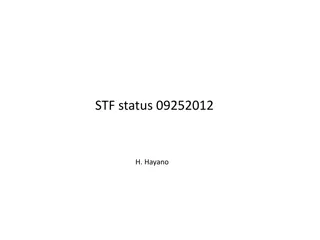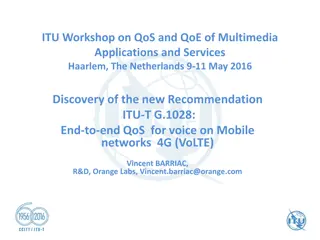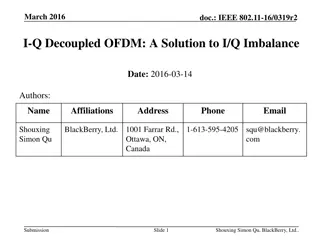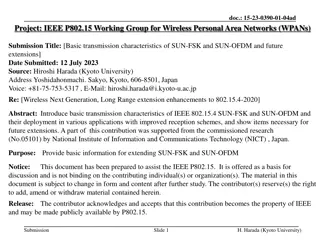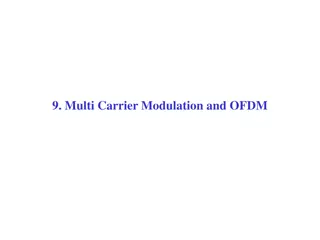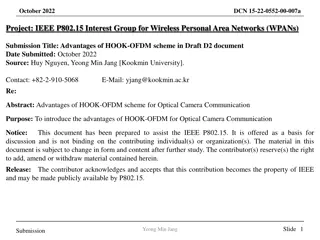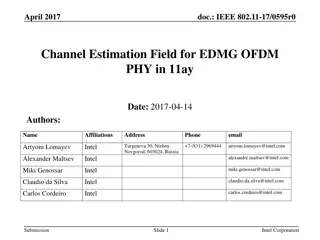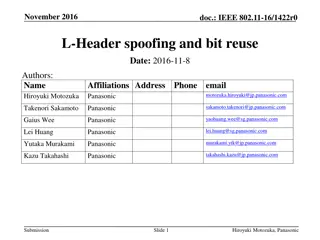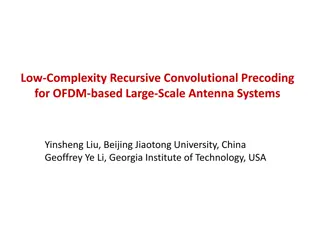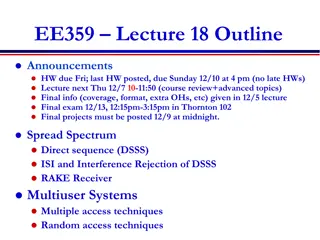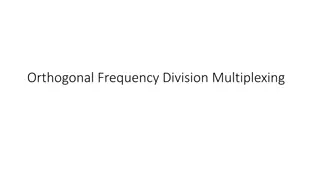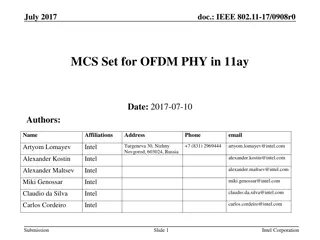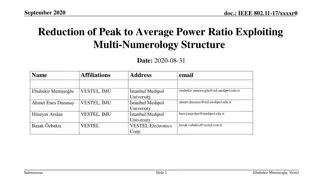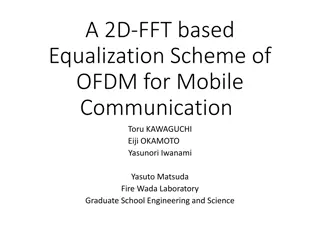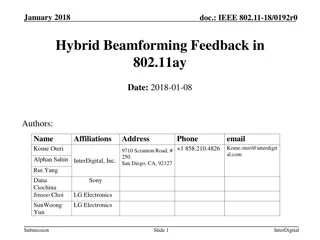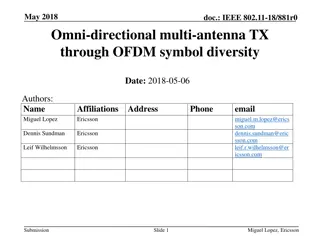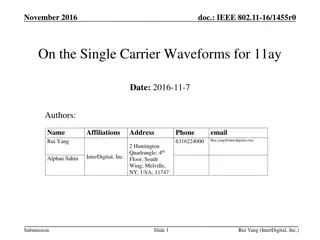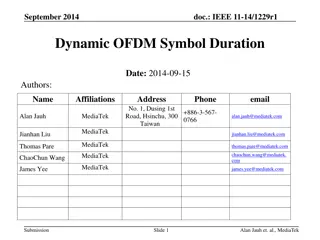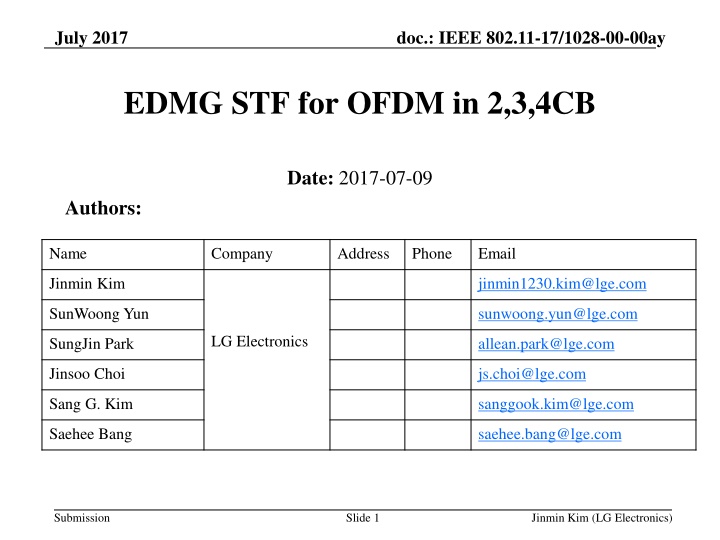
IEEE 802.11-17 EDMG STF for OFDM Overview
In this document from July 2017, the IEEE 802.11-17/1028-00-00ay EDMG STF for OFDM in 2,3,4CB is discussed. The focus is on the frequency sequences, orthogonal sequences, and other key aspects related to channel bonding. Detailed information on the proposed sequences and their recursive procedures is provided, along with insights on space-time streams and iterations.
Uploaded on | 0 Views
Download Presentation

Please find below an Image/Link to download the presentation.
The content on the website is provided AS IS for your information and personal use only. It may not be sold, licensed, or shared on other websites without obtaining consent from the author. If you encounter any issues during the download, it is possible that the publisher has removed the file from their server.
You are allowed to download the files provided on this website for personal or commercial use, subject to the condition that they are used lawfully. All files are the property of their respective owners.
The content on the website is provided AS IS for your information and personal use only. It may not be sold, licensed, or shared on other websites without obtaining consent from the author.
E N D
Presentation Transcript
July 2017 doc.: IEEE 802.11-17/1028-00-00ay EDMG STF for OFDM in 2,3,4CB Date: 2017-07-09 Authors: Name Company Address Phone Email Jinmin Kim jinmin1230.kim@lge.com SunWoong Yun sunwoong.yun@lge.com LG Electronics SungJin Park allean.park@lge.com Jinsoo Choi js.choi@lge.com Sang G. Kim sanggook.kim@lge.com Saehee Bang saehee.bang@lge.com Submission Slide 1 Jinmin Kim (LG Electronics)
July 2017 doc.: IEEE 802.11-17/1028-00-00ay Introduction In Draft 0.35, the EDMG-STF for OFDM in a single channel is defined. The key points of sequence are as follows: Frequency sequence 6 OFDM symbols 4 repetition pattern in a DFT period Mutually orthogonal sequence to prevent unintentional BF Low PAPR property / Good correlation performance In this contribution, we focus EDMG-STF in channel bonding cases. Submission Slide 2 Jinmin Kim (LG Electronics)
July 2017 doc.: IEEE 802.11-17/1028-00-00ay Proposed EDMG-STF for CB=2 (1/2) The sequence is defined in frequency domain 1st~6th EDMG-STF symbols: , 0 { = = i i i { , 0 , 0 , 0 , 385 } EDMG STF EDMGS EDMGS STS STS left STS rightt 386 , 386 , , 385 i i , 0 , 0 , 0 , 384 0 , } emdgs edmgs STS left STS rightt , , 384 where iSTS is the space-time stream number and 1 iSTS 8 i The sequences and are defined as follows: left edmgs 384 , i edmgs STS right STS , 384 = i ( / 4 ), n mod 4 1 A n n STS = i 5 ( ) edmgs n STS left , 384 0 , mod 4 1 = i ( / 4 ), n mod 4 2 B n n STS = i 5 ( ) edmgs n STS right , 384 0 , mod 4 2 Submission Jinmin Kim (LG Electronics) Slide 3
July 2017 doc.: IEEE 802.11-17/1028-00-00ay Proposed EDMG-STF for CB=2 (2/2) The sequences recursive procedure for iSTS=1, 2, , 8 , 1 , 1 [ ) ( 0 + + = n ASTS and are generated using the following STS i STS i A5 B5 ] 1 i = + + + STS i for iSTS=1, 2, , 8 ] 1 , , 1 [ ) ( 0 j n B Space-time stream number STS i k W [+1, +1, +1, +1, +1] [+1, +1, -1, +1, +1] [+1, -1, +1, +1, +1] [+1, -1, -1, +1, +1] [-1, +1, +1, +1, +1] [-1, +1, -1, +1, +1] [-1, -1, +1, +1, +1] [-1, -1, -1, +1, +1] 1 2 3 4 5 6 7 8 = STS i k STS i k STS i k STS i k ( ) [ ( ), ( )] A n W A n B n 1 1 = STS i k STS i k STS i k STS i k ( ) [ ( ), ( )] B n W A n B n 1 1 STS i k where k defines iteration index, the value of the weight for sequence of iSTS-th space-time stream and k-th iteration defines the W Submission Slide 4 Jinmin Kim (LG Electronics)
July 2017 doc.: IEEE 802.11-17/1028-00-00ay Proposed EDMG-STF for CB=3 (1/3) The sequence is defined in frequency domain 1st~6th EDMG-STF symbols: { 596 , 596 EDMGS STF EDMG = = i i i , 0 , 0 , 0 , 595 } EDMGS STS STS left STS rightt , , 595 i i , 0 , 0 , 0 { , 0 , 0 , 0 , 592 0 , 0 , 0 , 592 } edmgs edmgs STS left STS rightt , , where iSTS is the space-time stream number and 1 iSTS 8 The sequences and are defined as follows: left edmgs 592 , i i edmgs STS STS right , 592 , = i ( / 4 ), mod 4 1 subSeq n n STS left 148 , = i ( ) edmgs n STS left , 592 0 mod 4 1 n , = i ( / 4 ), mod 4 2 subSeq n n STS right 148 , = i ( ) edmgs n STS right , 592 0 mod 4 2 n Submission Slide 5 Jinmin Kim (LG Electronics)
July 2017 doc.: IEEE 802.11-17/1028-00-00ay Proposed EDMG-STF for CB=3 (2/3) STS i left STS i right subSeq subSeq The sequences and follows: ) ( 148 , left n subSeq = are defined as 148 , 148 , STS i i i i STS i [ , , , ] p A A A STS STS STS 4 4 4 = STS i right STS i STS i STS i STS i ( ) [ , , , ] subSeq n q B jB B 148 , 4 4 4 piSTS qiSTS Space-time stream number 1 2 3 4 5 6 7 8 [-j +j -j -j] [-j +1 +j +1] [+1 -j +1 -j] [+j -j -j +j] [+1 -j -1 -j] [-1 -j -1 -j] [+1 +1 +1 -1] [-j -j +j +j] [-j -j -j +j] [-j -1 +j -1] [+1 -1 -1 +1] [-j -1 -j -1] [-1 -j +1 -j] [+1 +1 -1 -1] [-1 +1 -1 -1] [-j +1 -j +1] Submission Slide 6 Jinmin Kim (LG Electronics)
July 2017 doc.: IEEE 802.11-17/1028-00-00ay Proposed EDMG-STF for CB=3 (3/3) The sequences recursive procedure for iSTS=1, 2, , 8 , 1 , 1 [ ) ( 0 + + = n ASTS and are generated using the following i i A4 B4 STS STS ] 1 i = + + + STS i for iSTS=1, 2, , 8 ] 1 , , 1 [ ) ( 0 j n B Space-time stream number STS i k W [+1, +1, +1, +1] [+1, +1, -1, +1] [+1, -1, +1, +1] [+1, -1, +1, -1] [-1, +1, +1, -1] [-1, -1, +1, -1] [-1, -1, -1, +1] [-1, -1, -1, -1] 1 2 3 4 5 6 7 8 = STS i k STS i k STS i k STS i k ( ) [ ( ), ( )] A n W A n B n 1 1 = STS i k STS i k STS i k STS i k ( ) [ ( ), ( )] B n W A n B n 1 1 STS i k where k defines iteration index, the value of the weight for sequence of iSTS-th space-time stream and k-th iteration defines the W Submission Slide 7 Jinmin Kim (LG Electronics)
July 2017 doc.: IEEE 802.11-17/1028-00-00ay Proposed EDMG-STF for CB=4 (1/3) The sequence is defined in frequency domain 1st~6th EDMG-STF symbols: { 805 , 805 EDMGS STF EDMG = = i i i , 0 , 0 , 0 , 804 } EDMGS STS STS left STS rightt , , 804 i i , 0 , 0 , 0 , 0 { , 0 , 0 , 0 , 800 0 , 0 , 0 , 0 , 800 } edmgs edmgs STS left STS rightt , , where iSTS is the space-time stream number and 1 iSTS 8 The sequences and are defined as follows: left edmgs 800 , 0 i i edmgs STS STS right , 800 = i ( / 4 ), mod 4 1 subSeq n n STS left , 200 = i ( ) edmgs n STS left , 800 , mod 4 1 n = i ( / 4 ), mod 4 2 subSeq n n STS right , 200 = i ( ) edmgs n STS right , 800 0 , mod 4 2 n Submission Slide 8 Jinmin Kim (LG Electronics)
July 2017 doc.: IEEE 802.11-17/1028-00-00ay Proposed EDMG-STF for CB=4 (2/3) i i The sequences and follows: ( 200 , left n subSeq are defined as subSeq subSeq STS left STS right , 200 , 200 = STS i STS i STS i STS i STS i STS i ) [ , , , , ] jA jA A A A 3 3 3 3 3 = STS i right STS i STS i i STS i i ( ) [ , , , , ] subSeq n jB B B jB B STS STS , 200 3 3 3 3 3 Submission Slide 9 Jinmin Kim (LG Electronics)
July 2017 doc.: IEEE 802.11-17/1028-00-00ay Proposed EDMG-STF for CB=4 (3/3) The sequences recursive procedure for iSTS=1, 2, , 8 , 1 , , [ ) ( 0 + + + = j j n ASTS and are generated using the following i i A3 B3 STS STS ] 1 + i , 1 for iSTS=1, 2, , 8 , 1 , 1 , [ ) ( 0 + + + + = j j n B ] 1 STS i , Space-time stream number STS i k W [+1, +1, +1] [+1, +1, -1] [+1, -1, +1] [+1, -1, -1] [-1, +1, +1] [-1, +1, -1] [-1, -1, +1] [-1, -1, -1] = STS i k STS i k STS i k STS i k 1 2 3 4 5 6 7 8 ( ) [ ( ), ( )] A n W A n B n 1 1 = STS i k STS i k STS i k STS i k ( ) [ ( ), ( )] B n W A n B n 1 1 STS i k where k defines iteration index, the value of the weight for sequence of iSTS-th space-time stream and k-th iteration defines the W Submission Slide 10 Jinmin Kim (LG Electronics)
July 2017 doc.: IEEE 802.11-17/1028-00-00ay PAPR performance The proposed EDMG-STF has acceptable PAPR properties in the table below Space-time stream number 1 2 3 4 5 6 7 8 NCB = 2 NCB = 3 NCB = 4 2.99 3.00 3.00 3.00 2.99 3.00 3.00 3.00 3.85 3.86 3.87 3.80 3.88 3.88 3.89 3.91 3.00 3.00 3.01 3.00 3.00 3.00 3.00 3.00 And, all sequences for space-time stream are mutually orthogonal Submission Slide 11 Jinmin Kim (LG Electronics)
July 2017 doc.: IEEE 802.11-17/1028-00-00ay Correlation performance(1/5) To investigate correlation performance, we use merit factor introduced in [1] N a F [1] M.J.E. Golay, Sieves for low autocorrelation binary sequences, IEEE Trans. Inform. Theory, IT-23, no. 1, pp. 43-51, 1977 2 = ( ) N k 1 a = i = N 1 ( k ) i a , 0 k N 1 = k 2 + a i k 2 ak ( ) 0 1 , where N defines sequence length Ga32 Ga64 Ga128 Proposed sequence Stream 1 Stream 2 Stream 3 Stream 4 Stream 5 Stream 6 Stream 7 Stream 8 CB=2 Merit factor 2.90 3.0 3.12 3.02 3.02 3.02 3.02 3.02 3.02 3.02 3.02 CB=3 2.70 2.81 2.73 2.65 2.65 2.65 2.76 2.65 CB=4 3.18 3.18 2.87 2.81 2.99 3.14 2.96 2.93 Proposed sequences have reasonable performance compared to legacy Golay sequences Submission Slide 12 Jinmin Kim (LG Electronics)
July 2017 doc.: IEEE 802.11-17/1028-00-00ay Correlation performance(2/5) For the comparison with STF in 11a/11n, we simulate autocorrelation performance in time domain 4repetition pattern in DFT period FFT size = 64,128 First peak = 1(normalized) Second Peak = 0.28, 0.28 STF in 11a(20MHz) STF in 11n(40MHz) 1 1 0.9 0.9 0.8 0.8 0.7 0.7 0.6 0.6 0.5 0.5 0.4 0.4 X: 5 Y: 0.2845 X: 3 Y: 0.2845 0.3 0.3 0.2 0.2 0.1 0.1 0 0 20 40 60 80 100 120 10 20 30 40 50 60 Submission Slide 13 Jinmin Kim (LG Electronics)
July 2017 doc.: IEEE 802.11-17/1028-00-00ay Correlation performance(3/5) Proposed STF for NCB=2 4repetition pattern in DFT period FFT size = 1024 First peak = 1(normalized) Second Peak = 0.29 1 0.9 0.8 0.7 0.6 0.5 0.4 0.3 X: 770 Y: 0.2912 0.2 0.1 0 0 200 400 600 800 1000 1200 Submission Slide 14 Jinmin Kim (LG Electronics)
July 2017 doc.: IEEE 802.11-17/1028-00-00ay Correlation performance(4/5) Proposed STF for NCB=3 4repetition pattern in DFT period FFT size = 1536 First peak = 1(normalized) Second Peak = 0.26 1 0.9 0.8 0.7 0.6 0.5 0.4 0.3 X: 1154 Y: 0.2663 0.2 0.1 0 0 200 400 600 800 1000 1200 1400 1600 Submission Slide 15 Jinmin Kim (LG Electronics)
July 2017 doc.: IEEE 802.11-17/1028-00-00ay Correlation performance(5/5) Proposed STF for NCB=4 4repetition pattern in DFT period FFT size = 2048 First peak = 1(normalized) Second Peak = 0.24 1 0.9 0.8 0.7 0.6 0.5 0.4 0.3 0.2 X: 1538 Y: 0.2496 0.1 0 0 500 1000 1500 2000 2500 Submission Slide 16 Jinmin Kim (LG Electronics)
July 2017 doc.: IEEE 802.11-17/1028-00-00ay Conclusion We proposed EDMG-STF in CB>1 Proposed sequence has acceptable performance compared to other preamble Submission Slide 17 Jinmin Kim (LG Electronics)
July 2017 doc.: IEEE 802.11-17/1028-00-00ay SP/M #1 Do you agree to include the text for EDMG-STF for EDMG OFDM mode in CB>1 proposed in (11-17-1029- 00-00ay-EDMG-STF for OFDM in 2,3,4CB Draft) to the spec draft? Submission Slide 18 Jinmin Kim (LG Electronics)


